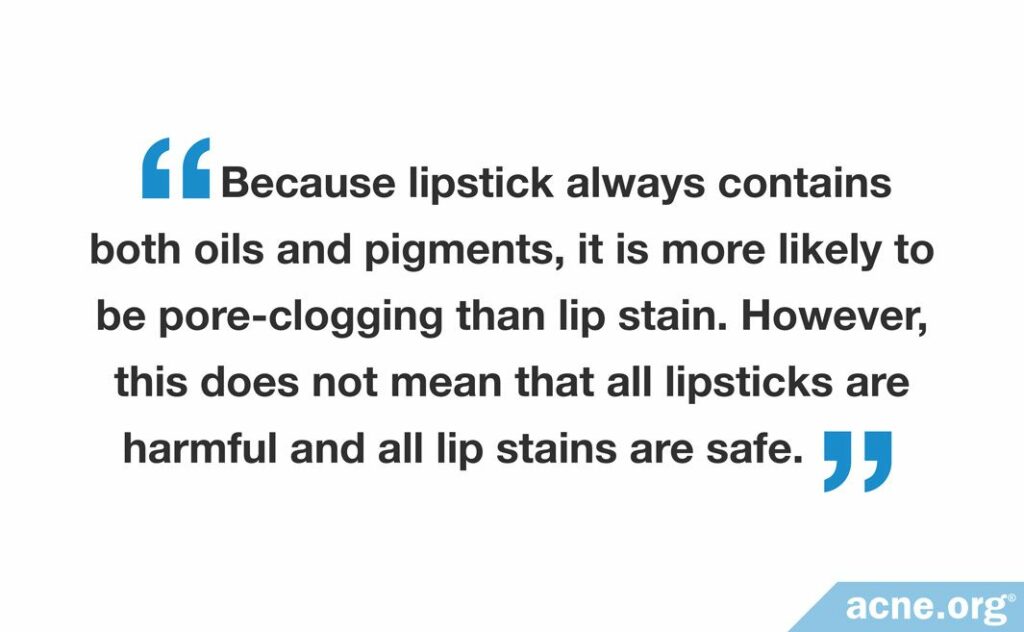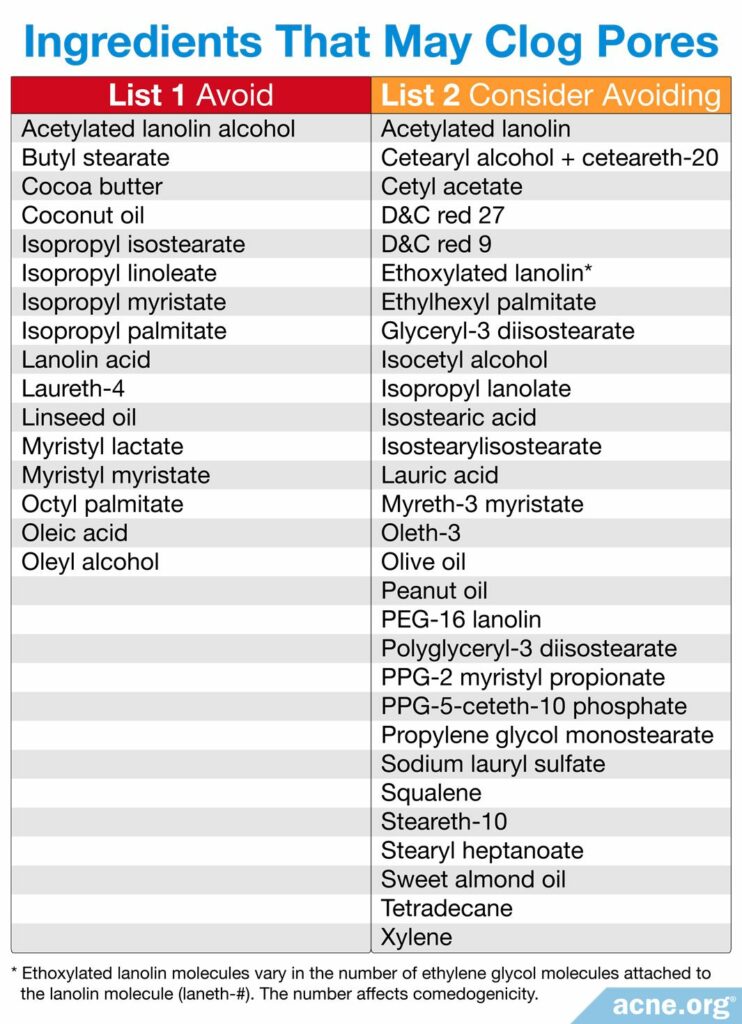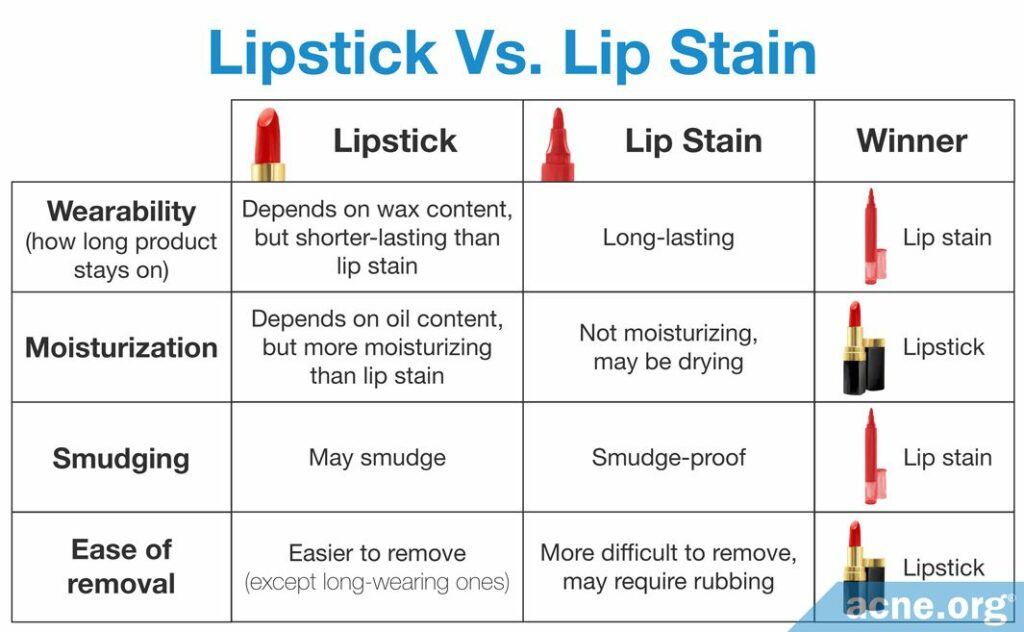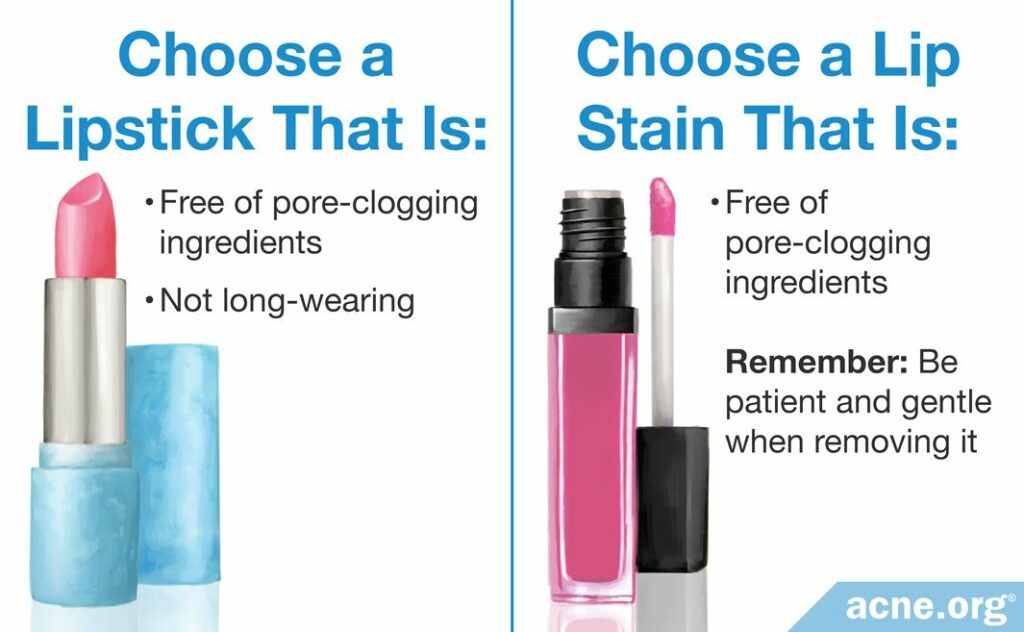Not Necessarily. Both Can Be Safe to Use on Acne-prone Skin If You Choose Lip Makeup That Is Free of Pore-clogging Ingredients and Stay Gentle When Removing It from the Lips.

The Essential Info
Lipstick and lip stain each have advantages and disadvantages when it comes to acne.
Lipstick:
- Advantage: Easier to remove without irritating the skin (except for long-wearing lipstick)
- Disadvantage: More likely to contain pore-clogging ingredients
Lip stain:
- Advantage: Less likely to contain pore-clogging ingredients
- Disadvantage: Can require more rubbing to remove, which may cause irritation and trigger acne
In general, it is safe to use either, depending on what you prefer. Just follow these common-sense tips:
Lipstick: Choose a lipstick free of comedogenic ingredients that is not long-wearing.
Lip stain: Choose a lip stain free of comedogenic ingredients and stay gentle when removing it.

The Science
When choosing a lipstick or lip stain, you may be concerned about how these cosmetics might contribute to acne. Although the lips themselves do not develop acne, lip products can transfer to the skin around the mouth, where they could potentially cause acne. In addition, we know that physically irritating the skin can aggravate acne, so if you have to rub the skin to remove your lip makeup, this could also contribute to acne.1
To date, there have been no studies comparing how likely lipstick and lip stain are to contribute acne. In the absence of such research, the best thing we can do is look at the ingredients of both lipstick and lip stain and look at how easy they are to remove from the lips without physically irritating the skin.
Ingredients in Lipstick and Lip Stain

- Lipstick: Waxes, oils*, pigments*; may contain vitamins, antioxidants, sunscreens, and/or herbal extracts2-4
- Lip stain: Water, alcohol, pigments*; may contain oils*, sunscreens, and/or herbal extracts
*Some oils and pigments are comedogenic, which means that they can clog skin pores and contribute to acne.5
Because lipstick always contains both oils and pigments, it is more likely to be pore-clogging than lip stain. However, this does not mean that all lipsticks are harmful and all lip stains are safe for acne-prone skin. It all depends on the specific ingredients in each particular product.
Before buying any lipstick or lip stain, or any other makeup product for that matter, always check the ingredient list to make sure it does not contain comedogenic ingredients or substances that irritate your skin or trigger allergies.
List of common comedogenic ingredients in makeup
Many scientific studies have looked at how likely various ingredients are to cause comedones (clogged pores).5 Based on a thorough review of this research, we have compiled two lists:
- Definitely avoid: A list of ingredients that people with acne-prone skin should definitely avoid, because a compelling body of evidence shows that they are comedogenic.
- Consider avoiding: A list of ingredients that people with acne-prone skin may want to consider avoiding, because a less compelling body of evidence suggests that they might be comedogenic.

Removing Lipstick and Lip Stain from the Lips
- Lipstick: Usually easy to remove. Avoid long-wearing lipstick, which is more difficult to remove.
- Lip stain: Can be difficult to remove. Be patient and use gentle motions.
Removing lipstick is not very likely to cause physical irritation of the skin. The exception is long-wearing lipstick, which sets more strongly and can be difficult to remove, potentially requiring rubbing, which can irritate the skin around the lips and contribute to acne. This is why it is best to avoid long-wearing lipstick.
Lip stain also sets quite strongly, so to avoid irritating the skin when removing lip stain, take your time and use gentle motions. Avoid rubbing or putting a lot of pressure on the skin around the lips.
Transfer to the Skin Around the Mouth
- Lipstick: More likely to smudge and transfer to the skin around the mouth
- Lipstain: Less likely to smudge and transfer to the skin around the mouth
The lips themselves cannot develop acne, but the skin around the mouth can. Because lipstick does not stay in place as well as lip stain, it is more likely to smudge the skin around the mouth, where acne can develop. However, either type of lip product can potentially smudge around the mouth. This is why it is very important to only buy lip products that are free of comedogenic ingredients.
Lipstick versus lip stain: The full scoop
Similarities Between Lipstick and Lip Stain
Both lipstick and lip stain are cosmetic products that serve several functions:
1. To color the lips in the desired shade
2. To define lip shape
3. To protect the skin of the lips from dehydration, particularly during dry, cold, and windy weather2,3
Differences Between Lipstick and Lip Stain
Lipstick and lip stain differ in (1) appearance, (2) ingredients, and (3) performance.
1. Appearance
- Lipstick: A stick of solid material packed into a tubular plastic container3
- Lip stain: A liquid or gel, either in a bottle or jar with an applicator wand, or as a marker pen4
2. Ingredients
Lipstick:
Waxes
Waxes are non-comedogenic (do not clog pores).
Waxes provide solidity so that the lipstick holds its shape. Waxes in lipstick can come from many different sources:
- Mineral-based waxes: for example, paraffin wax or petroleum wax
- Plant-based waxes: for example, sugarcane wax or candelilla wax
- Animal-based waxes: for example, beeswax or lanolin2,3
Lipsticks with a higher wax content tend to be “long-wearing,” which means that they stay on the lips longer.2 These lipsticks may be more difficult to remove and require rubbing, which could irritate the skin around the mouth and potentially trigger acne. In other words, although wax itself is not comedogenic, a lipstick with a lot of wax could be a bad choice for acne-prone skin.
Oils
Some oils in lipstick are comedogenic and are listed in the table of comedogenic ingredients above.
Oils in lipstick which serve two functions: (1) to soften the wax to allow smooth application of the product, and (2) to moisturize the lips.
The second function is important because the skin on the lips is more prone to dehydration than skin on other parts of the body. This is due to the fact that the skin on the lips is thinner than skin elsewhere and lacks oil glands.2,3 Normally, oil glands produce skin oil, which creates a film on the skin that prevents the skin from losing water. Since the lips lack these oil glands, they are prone to drying out and cracking, especially in dry, cold, and windy weather. To help the lips retain moisture, manufacturers add various oils to lipstick.
Two major types of oils are used to make lipstick:
- Volatile oils: oils that evaporate, for example, silicone-based oils
- Non-volatile oils: oils that do not evaporate, such as synthetic oils or vegetable oils2
Lipsticks with a high oil content tend to moisturize the lips well and make them look glossy, but these lipsticks wear off faster than lipsticks with less oil and more wax.2
Pigments
Some pigments are comedogenic and are listed in the table of comedogenic ingredients above.
Since the main function of lipstick is to color the lips, lipstick contains various pigments. Manufacturers tweak the combination and proportions of multiple pigments to create a wide variety of shades.2
Other optional ingredients
Some lipsticks contain additional ingredients, for example:
- Vitamins
- Antioxidants
- UV filters
- Herbal extracts6
Lip stain:
Water
Water is not comedogenic.
Lip stains are typically water-based. Because of this, when you apply lip stain, it sets quickly, which means that it dries on the lips and stays in place. This means that you have to be careful and precise when applying lip stain.
On the plus side, once set, lip stain usually will not transfer to the skin around the mouth, to the teeth, or to your clothes.
Alcohol
Alcohol is not comedogenic.
Most lip stains contain alcohol, which helps the color penetrate into the skin. This is another reason why lip stains tend to stay in place for a long time. However, alcohol may also dry the lips.
Pigments
Some pigments are comedogenic and are listed in the table of comedogenic ingredients above.
Like lipstick, lip stain contains various pigments. Manufacturers tweak the combination and proportions of multiple pigments to create a wide variety of shades.2
Other optional ingredients
Some lip stains contain additional ingredients, for example:
- Small amounts of oils
- UV filters
- Herbal extracts
3. Performance
Because of their different ingredients, lipstick and lip stain each have strengths and weaknesses.


In conclusion, lipstick and lip stain can both be safe for people with acne-prone skin, as long as you follow these tips:
- Lipstick: Choose a lipstick that is free of comedogenic ingredients and is not long-wearing
- Lip stain: Choose a lip stain that is free of pore-clogging ingredients, and be patient and gentle when removing it from the lips
References
- Mills, O. H. & Kligman, O. (1975). Acne mechanica, Archives of Dermatology, 111, 481-483. https://www.ncbi.nlm.nih.gov/pubmed/123732
- Engasser, P. G., Lip Cosmetics, Dermatologic Clinics, 18(4), 641-649, (2000). https://www.sciencedirect.com/journal/dermatologic-clinics/vol/18/issue/4
- Available from: https://en.wikipedia.org/wiki/Lipstick. Accessed on 7/10/2017.
- Available from: https://en.wikipedia.org/wiki/Lip_stain. Accessed on 7/10/2017.
- Katoulis A. C., Kakepis E. M., Kintziou H., Kakepis M. E. & Stavrianeas N. G., Comedogenicity of cosmetics: a review, Journal of the European Academy of Dermatology and Venereology, 7,115-119(1996). https://onlinelibrary.wiley.com/doi/abs/10.1111/j.1468-3083.1996.tb00606.x
- El-Nokaly, M., Walling, D. W., Vatter, M. L. & Leatherbury, N. C. Lipsticks compositions containing association structures, United States Patent, No 6,325,995. Date: December 4, 2001. https://patents.google.com/patent/US6325995
 Acne.org Products
Acne.org Products